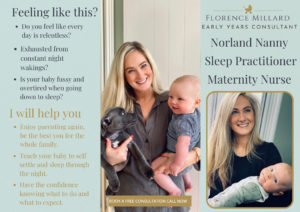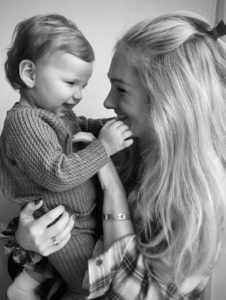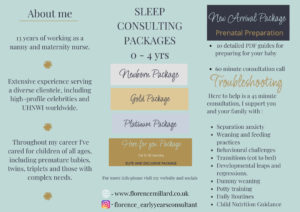Early years consultant Florence Millard shares her knowledge & experience.
Do you feel like every day is relentless ?
Are you missing a good night’s sleep?
Have you tried rocking, shushing, feeding, cuddling, car journeys the lot and at your wits end?
Can you imagine popping your little one down into their cot saying goodnight and the next time you see them is at 7am?

For the past 13 years, I’ve been working as a Norland Nanny and Maternity Nurse, and it has been an incredible journey. Throughout my career, I’ve had the privilege of caring for children of all ages, including premature babies, twins, triplets, and those with complex needs.
More recent to date I have qualified as a Certified Paediatric Sleep Practitioner.
I have recently set up my own business as an Early Years Consultant, providing tailored sleep packages as well as covering all areas in those early years.
My primary goal is to provide you with the upmost support and guidance whilst building a trusting relationship where you feel comfortable. I will be by your side every step of the way, offering evidence-based guidance. I strongly believe in educating and advising to help you establish lifelong good sleep habits.

I can help you achieve consistent full night’s sleep effortlessly with the confidence knowing what to do and what to expect no matter what.
Those sleepless nights will be a distant memory with my tried and proven methods backed by the science of sleep.
I want you to know you have not failed and you are not alone. Getting your children to sleep can be highly stressful and very quickly end up with bad habits not knowing how you have got there.
There is an abundance of advice available, making it difficult to know where to seek guidance. This often leads to feeling overwhelmed and attempting a multitude of approaches, none of which seem to be effective. As a result, frustration sets in, discouraging further attempts to seek assistance due to a sense of disappointment and let-down.
I’ve successfully assisted families dealing with situations where their children were waking up as many as 15 times a night and demanding 8 bottles, and I managed to help them achieve a full night’s sleep within just 2 days. Here’s how: I started with a thorough hour-long consultation call with the family, followed by an assessment of their sleep hygiene and environment. I had them maintain a sleep diary, which guided me in creating a personalised, step-by-step plan. Throughout the week, I provided support via WhatsApp to guide them through the process.

Where to start?
Night waking occurs regularly throughout the night. The majority of deep sleep occurs in the first few hours of the night. Night terrors, sleepwalking, and sleep talking manifest as we transition from deep to lighter sleep. REM sleep, also known as active sleep, is the phase during which emotional dreaming takes place, infants spend up to 50% of their sleep in this stage.
Have you ever wondered why your baby or child wakes up feeling refreshed, while you feel exhausted despite seemingly both being awake for the same duration? Well, when they initially fall asleep, they enter stages 3 and 4 of their sleep cycles, obtaining much needed deep sleep. Just as you’re about to settle into sleep a few hours later, they often wake and progress through lighter sleep cycles for the remainder of the night, just when you’re seeking deep sleep. This implies that you might not be entering deep sleep at all, remaining in the lighter stages 1 and 2 throughout the night, thereby missing out on crucial deep sleep. This is the stage during which growth hormones are released, tissue repairs occur, and memories are consolidated which is paramount to physical and mental wellbeing.
An infant’s circadian rhythm starts to develop around 6 weeks but isn’t fully set until anywhere between 3-6 months depending on each baby.
There’s no need to worry or feel stressed. If you have a baby who is 6 or 8 weeks old, it’s completely normal for their days to be unpredictable and different from each other. Don’t put pressure on yourself to have a strict routine during this time. Just remember that these variations in their daily routines are a typical part of their development.

What you can do is create a conducive sleep environment from 4 weeks.
Think of this phase as a rehearsal for the main event: your baby learning to settle independently in their cot. Each practice session, whether lasting 5 or 10 minutes, brings you closer to that goal. If your baby makes a noise or cries, pause before picking them up, 2 to 4 minutes will give them the chance to self settle, as they will frequently be in REM sleep also referred to as active sleep. Your baby may twitch or jerk their arms and legs, flutter their eyelids, show rapid breathing and vocalise with grunts or crying out. This falls by 30% by the age of three.
Remember, every baby is different, so the process might be shorter or longer depending on their individual needs.

Consistency is the key for babies and children to thrive which means you will also be thriving.
Implementing consistency into their daily routine going down for naps the same time each day will teach them when to expect sleep that they will be happily ready for, which gives you predictable nap times.
Establishing an optimal sleep environment for your child. Ensure their bedroom is sufficiently dark, using only amber or red lights due to melatonin, a crucial sleep-regulating chemical, profoundly effected by light. The release of melatonin can be influenced by light, which holds the most significant sway over our circadian rhythm.
Maintain the correct room temperature, avoiding excessive stimulation whilst creating a calm and soothing environment for your baby.
A bath taken 30 minutes before bedtime can help to promote melatonin production.
Strive for a minimum of one hour dedicated to winding down prior to sleep. Refrain from screen time for up to two hours before bed. Instead, opt for reading stories, listening to an audiobook, or engaging in gentle role play, depending on the child’s age.
Implementing good sleep habits such as watching out for the sleepy cues, so they don’t get overtired or under-tired. Putting them down awake not drowsy, not picking them straight away but giving them the chance to settle themselves.
Consistent sleep associations to give them that comfort they need to sleep such as a muslin or singing the same song each time they are laid down. White noise, a dummy or my personal favourite swaddling them.

I would then look at daytime sleep are they having too much or not getting enough, both will have a huge impact on night-time sleep causing false starts waking 45 minutes after falling asleep as well as early rising.
Over-tiredness is such a common cause for children struggling with sleep. It causes them to produce too much cortisol making it extremely difficult for them to fall asleep.
Are they getting enough active play in the daytime?
For example, if you have a 2 month old, they still need stimulating an activity for them can be as simple as talking or singing to them, have mirrors in-front of them during tummy time, have them follow a selection of objects, make it fun with some sensory lights and sounds.

Teaching them to fall asleep on their own is the primary goal. Once they achieve this and can also settle themselves when they wake, the sleep training process is complete. The way they learn to fall asleep is the same way they’ll need to fall back asleep. For example, if you rock them to sleep at bedtime, they’ll expect the same when they wake at 3 am. Our focus is on guiding them to master independent sleep.
Don’t worry if you are already in these habits, within a few days sticking to a step-by-step plan and consistency they will be no more.
Depending on the age of your child and approach you feel most comfortable with I would advise which self settle method to use and which would be most effective.
Be kind to yourself, children don’t come with a manual, you’re doing great.




